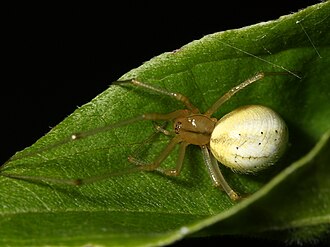Theridiidae
Theridiidae, commonly known as cobweb spiders or comb-footed spiders, is a large family of arachnids that includes over 2,200 species in more than 100 genera. The family is well-known for its members' unique web-building behaviors and the diverse environments they inhabit, ranging from forests and deserts to human dwellings. One of the most famous members of this family is Latrodectus, the genus that includes the black widow spiders.
Characteristics
Members of the Theridiidae family are distinguished by their tangle webs, which are irregular, messy, and sticky. Unlike the orderly orb webs of Araneidae spiders, cobweb spiders create a three-dimensional space of silk threads to trap their prey. These spiders have a comb of serrated bristles, or setae, on their fourth pair of legs, which they use to fling silk over their prey, effectively immobilizing it.
The size and appearance of Theridiidae spiders can vary greatly. They typically have a globular abdomen and a relatively small cephalothorax. Coloration is species-dependent, ranging from dull to bright and sometimes mimicking other more dangerous species as a form of Batesian mimicry.
Behavior and Ecology
Theridiidae spiders are predominantly insectivorous, preying on insects and other small arthropods caught in their webs. Some larger species have been known to capture small vertebrates. Their silk is not only used for capturing prey but also for constructing egg sacs and as a means of locomotion in a behavior known as ballooning, where young spiders disperse by floating on the wind with silk threads.
These spiders exhibit a wide range of reproductive behaviors, including complex courtship rituals to avoid cannibalism, which is common in the family. Females often produce multiple egg sacs over their lifetime, which they fiercely protect.
Distribution
The Theridiidae family is cosmopolitan, with species found on every continent except Antarctica. Their adaptability to various climates and habitats, including human residences, contributes to their wide distribution.
Human Interaction
While most Theridiidae spiders are harmless to humans, a few, like the black widow spiders of the Latrodectus genus, possess venom potent enough to cause significant health issues in humans. Symptoms of a black widow bite may include pain, muscle rigidity, vomiting, and sweating. However, fatalities are rare, and effective treatments are available.
Despite the fear they often inspire, Theridiidae spiders play a beneficial role in controlling insect populations, including pests in homes and gardens.
Conservation
The conservation status of Theridiidae species varies widely. While many species are common and not of concern, others are threatened by habitat loss, pollution, and climate change. Efforts to conserve arachnid habitats are crucial for the protection of these diverse and ecologically important creatures.
Transform your life with W8MD's budget GLP-1 injections from $125.
W8MD offers a medical weight loss program to lose weight in Philadelphia. Our physician-supervised medical weight loss provides:
- Most insurances accepted or discounted self-pay rates. We will obtain insurance prior authorizations if needed.
- Generic GLP1 weight loss injections from $125 for the starting dose.
- Also offer prescription weight loss medications including Phentermine, Qsymia, Diethylpropion, Contrave etc.
NYC weight loss doctor appointments
Start your NYC weight loss journey today at our NYC medical weight loss and Philadelphia medical weight loss clinics.
- Call 718-946-5500 to lose weight in NYC or for medical weight loss in Philadelphia 215-676-2334.
- Tags:NYC medical weight loss, Philadelphia lose weight Zepbound NYC, Budget GLP1 weight loss injections, Wegovy Philadelphia, Wegovy NYC, Philadelphia medical weight loss, Brookly weight loss and Wegovy NYC
|
WikiMD's Wellness Encyclopedia |
| Let Food Be Thy Medicine Medicine Thy Food - Hippocrates |
Medical Disclaimer: WikiMD is not a substitute for professional medical advice. The information on WikiMD is provided as an information resource only, may be incorrect, outdated or misleading, and is not to be used or relied on for any diagnostic or treatment purposes. Please consult your health care provider before making any healthcare decisions or for guidance about a specific medical condition. WikiMD expressly disclaims responsibility, and shall have no liability, for any damages, loss, injury, or liability whatsoever suffered as a result of your reliance on the information contained in this site. By visiting this site you agree to the foregoing terms and conditions, which may from time to time be changed or supplemented by WikiMD. If you do not agree to the foregoing terms and conditions, you should not enter or use this site. See full disclaimer.
Credits:Most images are courtesy of Wikimedia commons, and templates, categories Wikipedia, licensed under CC BY SA or similar.
Contributors: Prab R. Tumpati, MD






